
Pune wins Sustainable Transport Award
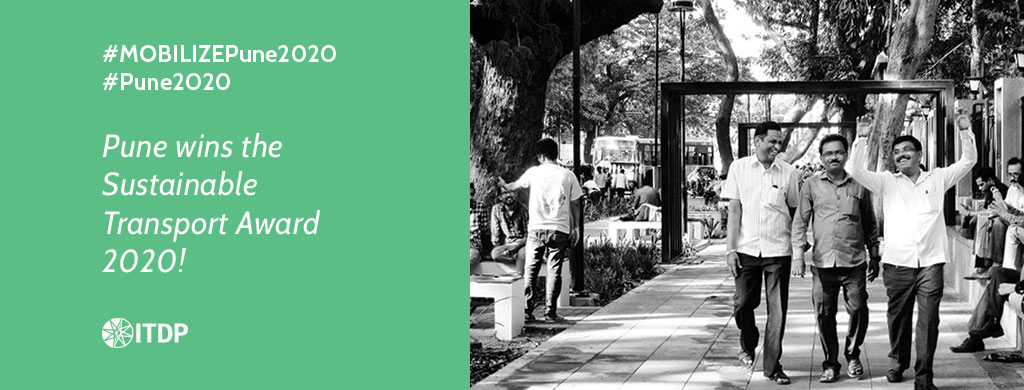

Promoting sustainable and equitable transportation worldwide

by admin

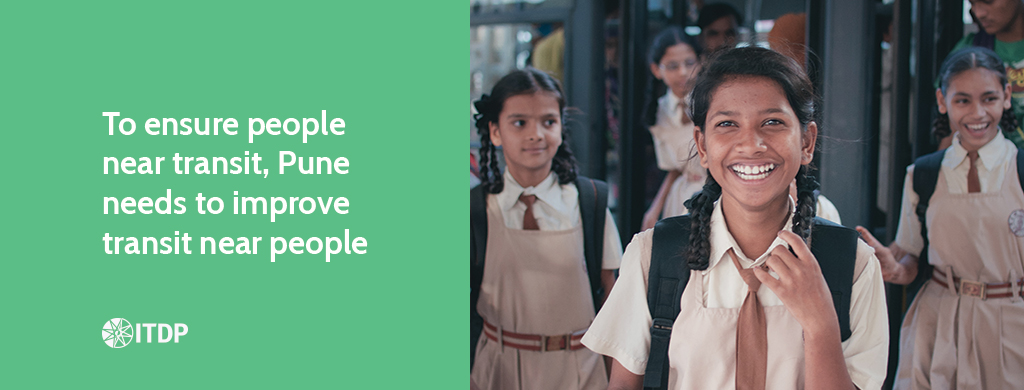
by admin
In Pune and Pimpri-Chinchwad, 96% of residents live within a 500m walkable distance of a bus network. But, as per Pune Mahanagar Parivahan Mahamandal Limited (PMPML) schedules, one-third of these residents don’t have access to buses which are available frequently – every five minutes. Therefore, a lowly 12% of the trips made in the region are via bus transit.
Though a five-minute wait seems ideal, this figure is an aggregation of areas with high bus availability and low ridership and of localities with low bus availability and high ridership.
This begs the question, what good are extensive transit systems which can’t ensure accessibility and high frequency. These are some of the key arguments the People near Transit (PNT) report, prepared by the ITDP India Programme, raises with regard to access to public transit and surging personal motor vehicle dependency in the Pune Metropolitan Region.

From time immemorial, cities have been built upon transit. Be it citadels built around trading routes to present-day cities with interwoven networks connecting residents to their place of work, education, leisure, etc. Hence, transit and accessibility to these systems remain central to the development of societies.
Indian cities have been growing at a tremendous scale. This growth poses many urban transportation challenges and though tottering, public transit has stood its ground as an indispensable public utility. But as the automobile industry’s clout grows, more motor vehicles, of various kinds, offer “freedom” at the cost of congested roads and choked cities.
Whereas, accessible, affordable, and frequent public transit offers a guarantee for mobility, which also furthers the economic and social mobilisation of citizens.
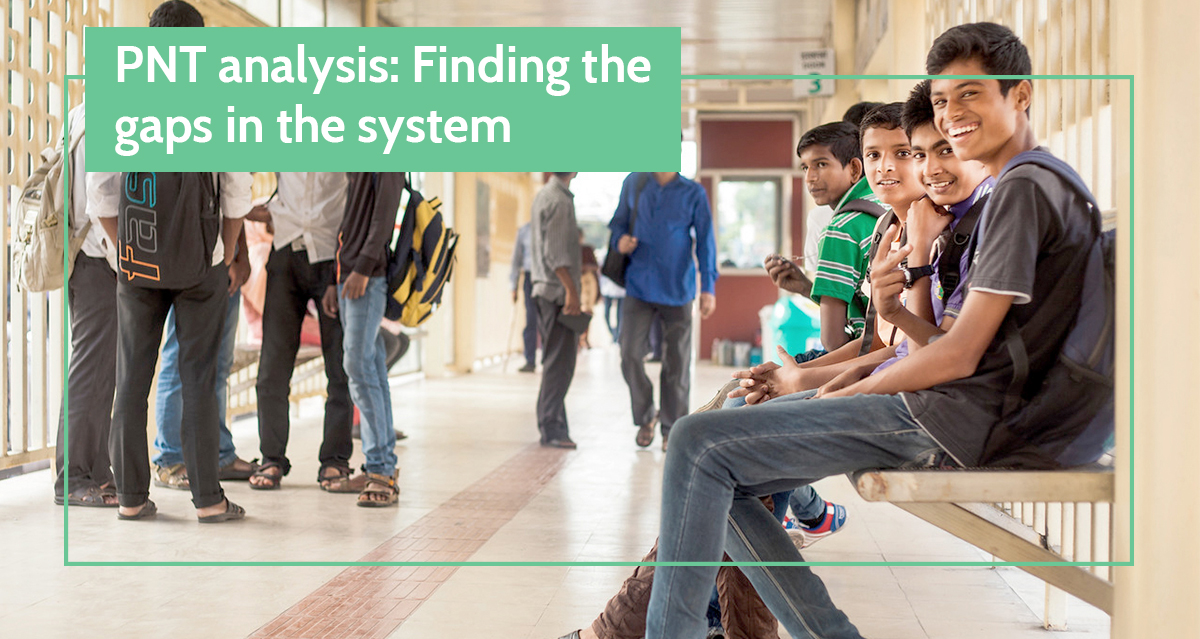
Basically, the PNT analysis measures how well a city provides transit access to its residents. The USP of the analysis is that it works on secondary sources to formulate the assessment. Quite handy for Indian cities, as most lack primary data on transport operations and functions.
To start off, PNT requires basic data like ward boundaries and their population to establish demand. Next, details regarding the routes, schedule, and station placements of various modes — such as bus and rail — help ascertain accessibility and frequency of these modes. These data points, in a digitised GIS format, find accessibility levels of public transit and identify gaps in the system.
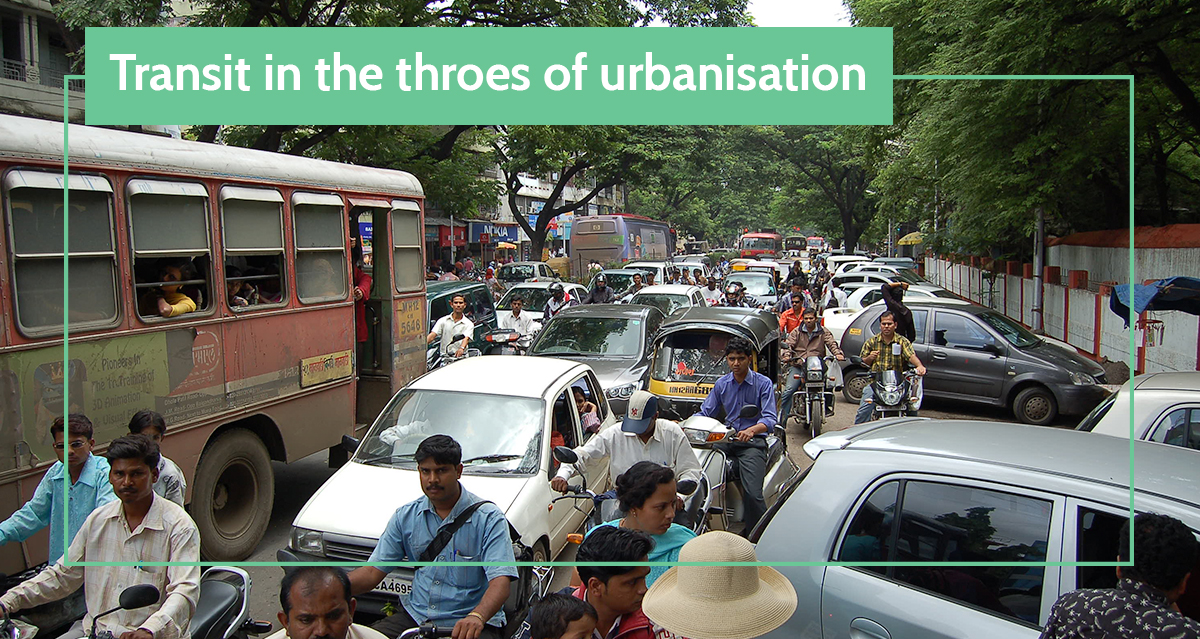
In the last two decades, the Pune urban agglomeration, including Pimpri-Chinchwad, has witnessed a steep economic and population growth. The IT (information technology) boom orchestrated a massive migration to Pune city. This advent doubled its population, but it pales in comparison to the city’s vehicle population — which grew by 700% in the period.
Adding to the congestion is the issue of urban sprawl. A symptom of urbanisation, urban sprawl is when cities grow unplanned towards their peripheries. It is estimated to cost Indian cities close to $1.8 trillion per year by 2050. Presently in Pune, this outward sprawl forces 48% of its trips to be longer than 5km. And in situations where public transit isn’t readily accessible or frequent, many residents — of areas like Shivane, Pirangut, Wagholi, etc., — are forced to use two-wheelers to commute.
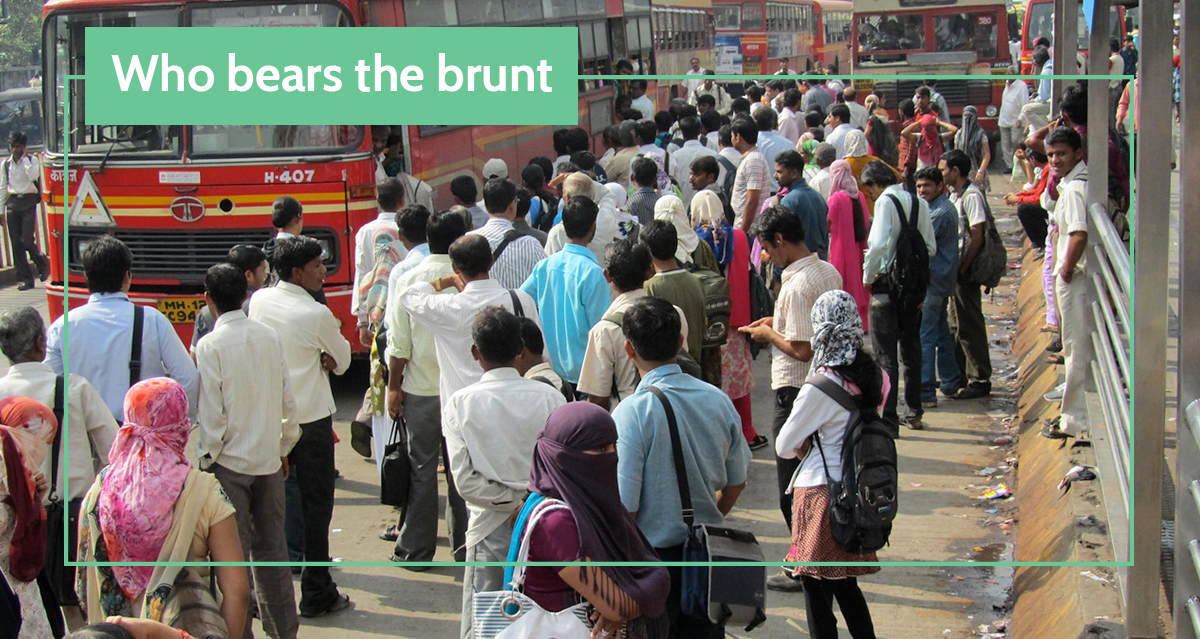
Many high-density areas like Dhanori, Kalyani Nagar, Warje-bypass, Pradhikaran, Talwade, etc., fall under the category of transit deserts. These are sections which do not have access to frequent transit — a public transit available every five minute — within a 500 m walking distance. Here’s where the “ideal five-minute wait-time for a bus” takes a hit, as accessibility (or lack thereof) to public transit trumps the former.
At the onset of this piece, we spoke about how mobility is key for the economic and social mobility of citizens. Now, interlay the situation of the lack of accessibility with the need of the people residing in transit deserts. There are breadwinners who struggle for hours in transit to reach work and back; caregivers whose daily regimes pivot around that one over-crowded bus and missing which throws the day into a chaotic convulsion of catching up; and then children whose means to education literally hangs on the footboards of these overcrowded buses.
In Pune region, work trips account for half of the total trips. As per the PNT report, only 62% of employment centers have access to frequent public transit. Key employment areas near Mundhwa and Bhekrai Nagar are transit deserts. While 40% of school-children don’t have access to frequent transit services to their schools.
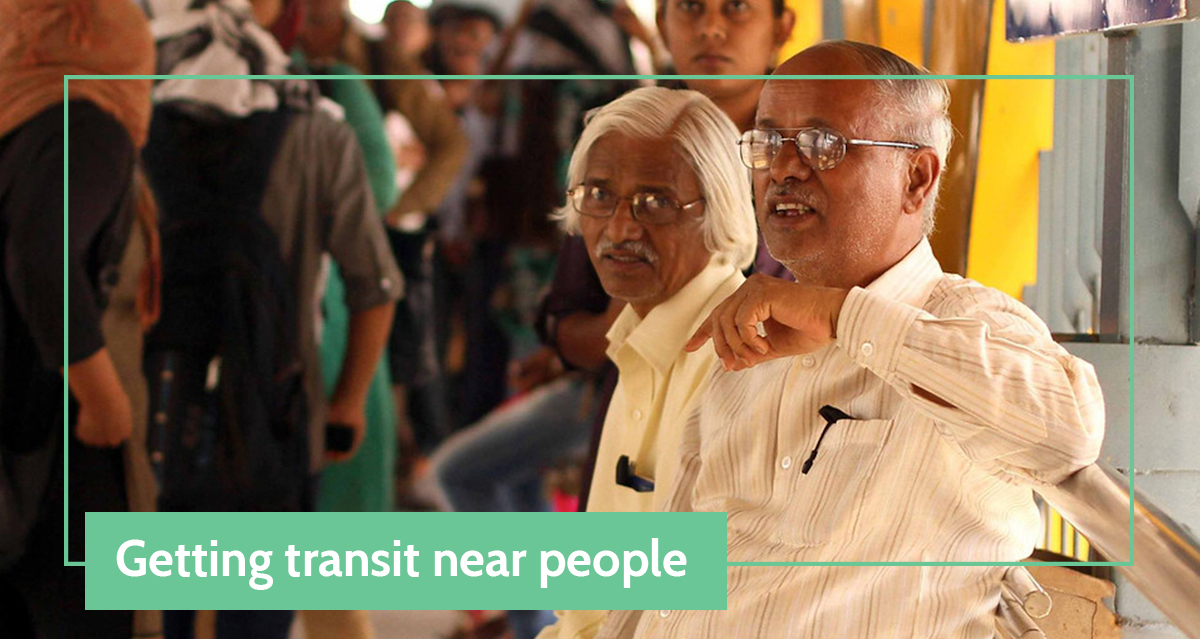
Transit interventions best work when they take into account the needs of every citizen. Despite being capital-intensive, the much-anticipated Metro Rail project, running through the twin cities, will be accessible to only 10% of people within a 500m walking distance. Even with the Rainbow BRT (existing and upcoming), rapid transit is accessible to only 25% of people.
Now, with 23% of low-income sections not having access to frequent transit, investing in rapid transit projects with high-cost and low returns (or ridership) is a self-inflicted “catch-22”. Neither is the Metro accessible nor would it be affordable to a vast majority of the public. As for the BRT, the lack of fleet expansion and network limitations bottle up the system’s potential.
The PNT analysis has some concrete and well-versed answers to the twin cities’ dilemma of improving public transit that works to serve all. These are:
The PNT report provides a thorough glimpse into the current capacities of public transit operations in Pune and Pimpri-Chinchwad. At the same time, the analysis can pave the way for interventions that can maximise the density of city layouts, accessibility, and frequency of public transit; while minimising urban sprawl, transit deserts. To conclude, PNT is an instrument for change that holds the potential to shape public transit that serves maximum and pollutes minimum.
Written by Rohit James
Edited by Kashmira Dubash
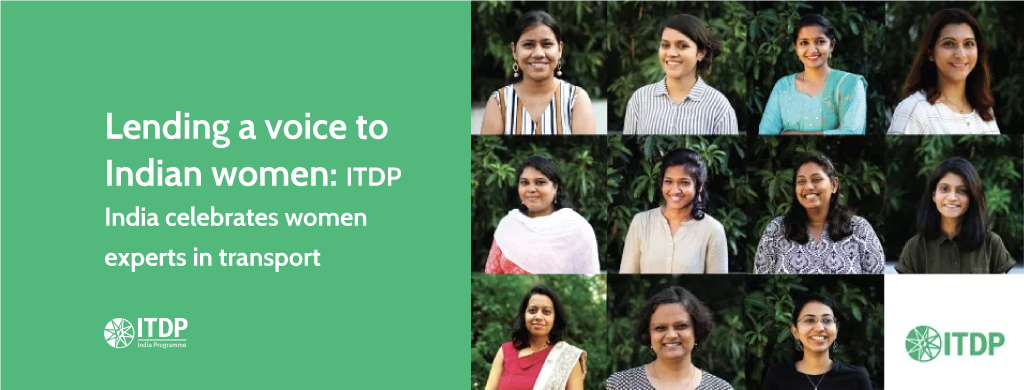
by admin
“I wish they’d quit giving me cufflinks as souvenirs at these conferences,” said an ITDP transport expert after her return from another male-dominated transport conclave. Though such instances of sole woman representations at events is still a common occurrence, the culture is limping on its last leg. As more women transcend the ranks of various hierarchies (societies and workforce), cities are scrambling to pay heed to the needs and demands of the upcoming generations.
This Women’s Day we celebrate the lives and journeys of ITDP India transport experts who ventured into the sustainable transport sector to lend a voice to the many Indian women. Read more on why each of them chose to be a part of the change they wish to see everyday.






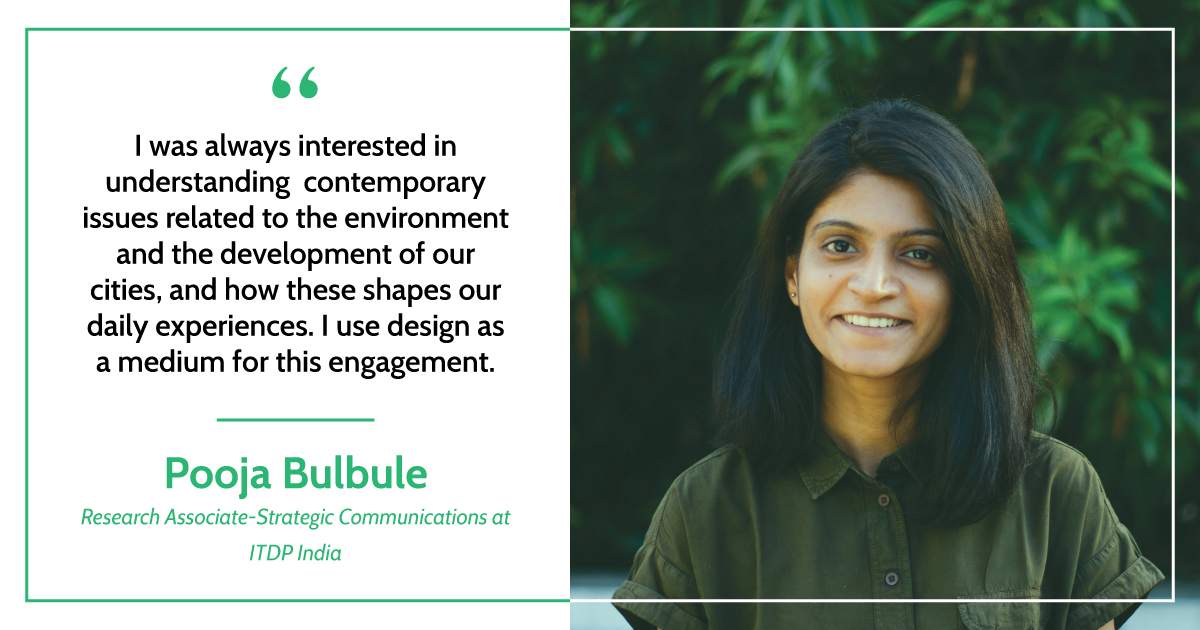




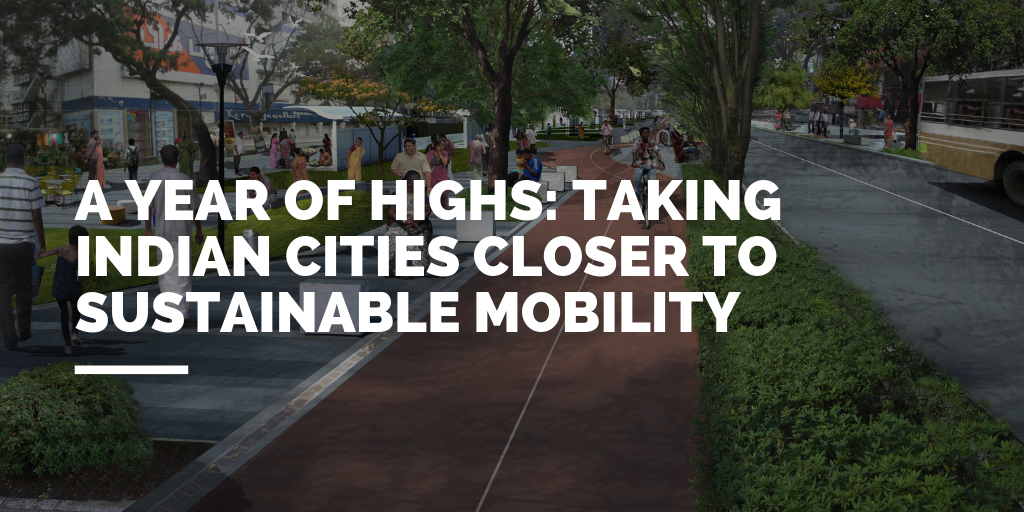
by admin
The path to urban development is laid with good intentions but the one paved for sustainable development is full of good work.
A take on the age-old proverb, this is exactly the ethos that the ITDP India Programme has persevered for, while mobilising the landscape of India’s transport system. This effort, to infuse the principles of equality and sustainability to the core of urban mobility, was taken up a notch in 2018.
The year marked the India Programme’s two decades of catalysing change in over a third of urban India. In this pursuit, of creating better streets, better cities, and better lives, the ITDP India Programme registered some major wins and here are some of the notable achievements in 2018:
Creating Complete Streets for all
The Indian state of Tamil Nadu is grappling with a myriad of urban transport and related infrastructure issues—resulting in congested roads, unbreathable air quality, and increasing road fatalities. Another cause of concern is the struggle endured by its most vulnerable road users—pedestrians and cyclists who vie not just for space but for their lives.
To change the existing state of affairs, the Tamil Nadu Commissionerate of Municipal Administration (CMA) led the Transforming Tamil Nadu project. With technical assistance from the ITDP India Programme, the project aims to implement Complete Streets in ten of its most populous cities, other from Chennai—Coimbatore, Erode, Madurai, Salem, Thanjavur, Tirunelveli, Thoothukudi, Tiruppur, Trichy, and Vellore.
Over a period of nine months, the India Programme held ten workshops to sensitise over 300 officials, from these ten cities, on ways to identify, map, plan, and implement city-wide street master plans that prioritise walking, cycling, and access to public transport.
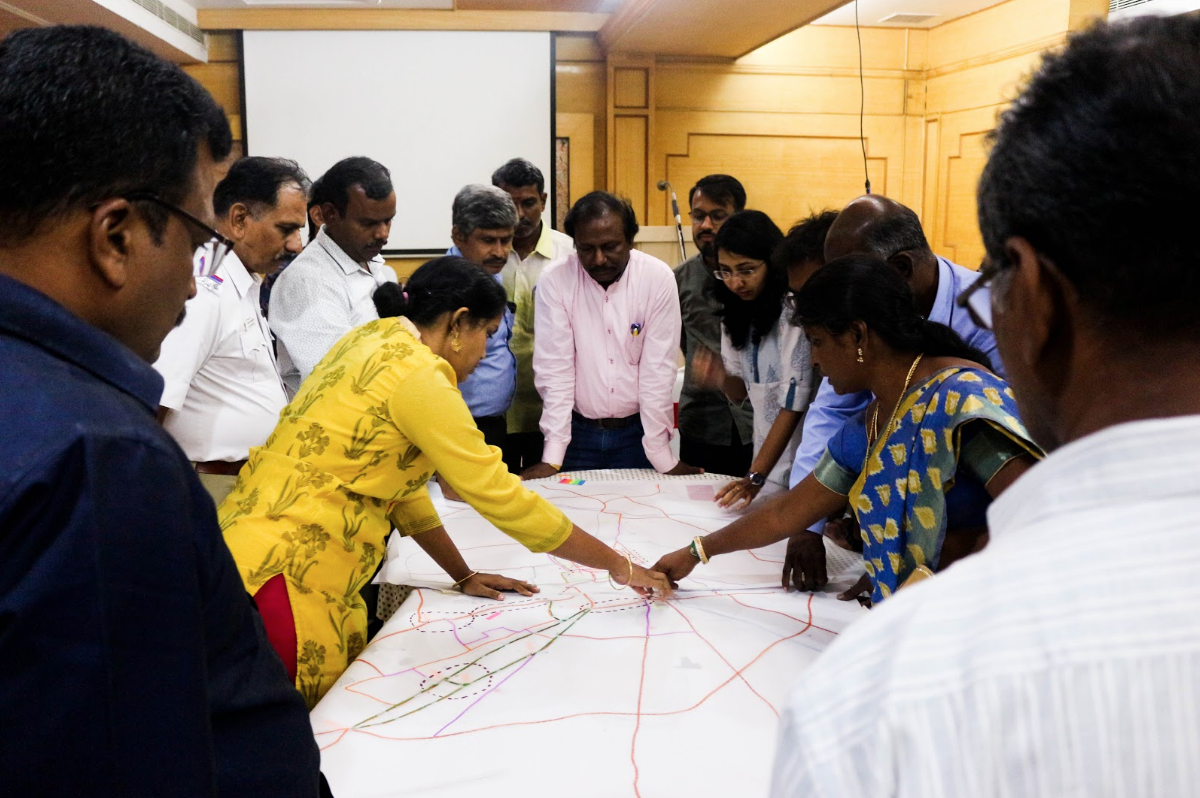
As a result, the state has announced its intentions to raise Rs 20,000 crore to redevelop 1,700 km of urban streets across these cities. The objective being: improve safety, accessibility, and liveability for all road users. To set precedent, the India Programme will work with GIZ Smart-SUT to help pilot city-wide plans for walking and cycling in three cities; gradually scaling the project to other cities in Tamil Nadu.
Riding ahead with a public bicycle sharing system
Caught in a transitional phase, Ranchi’s formal transport system hasn’t been able to meet its growing travel demands. This has allowed two-wheelers and share autos to flood the market and fill in the void. As the capital city of Jharkhand prepares for course correction, the ITDP India Programme is providing its technical expertise to pioneer the much-awaited ‘public bicycle sharing (PBS) system’ with 1,200 cycles!
A first in Jharkhand, the construction of the system began in early 2018 to provide a healthy, pollution-free mode of transport that is linked to transit networks. Hence, reducing dependence on two-wheelers. Ranchi is now in the midst of procuring 600 cycles as part of phase-I, which is expected to be completed by early 2019.

Embedding best practices in policy work
With 1,260 vehicles per km, Pune, one of Maharashtra’s larger city, has the second highest vehicle density in India. City administrators realise that pre-emptive measures to stifle private vehicle growth is the need of the hour.
After years of deliberation, the elected representatives of Pune gave their seal of approval to a progressive on-street parking policy in 2018. The policy, prepared with ITDP India Programme’s technical expertise, aims to streamline on-street parking and dissuade the use of personal cars and two-wheelers. Post implementation, valuable land currently encroached by haphazard parking could be transformed into vibrant public spaces—free from the nuisance of motor vehicles. Keenly interested in regulating parking management, Pimpri-Chinchwad was inspired to adopt a similar parking policy.
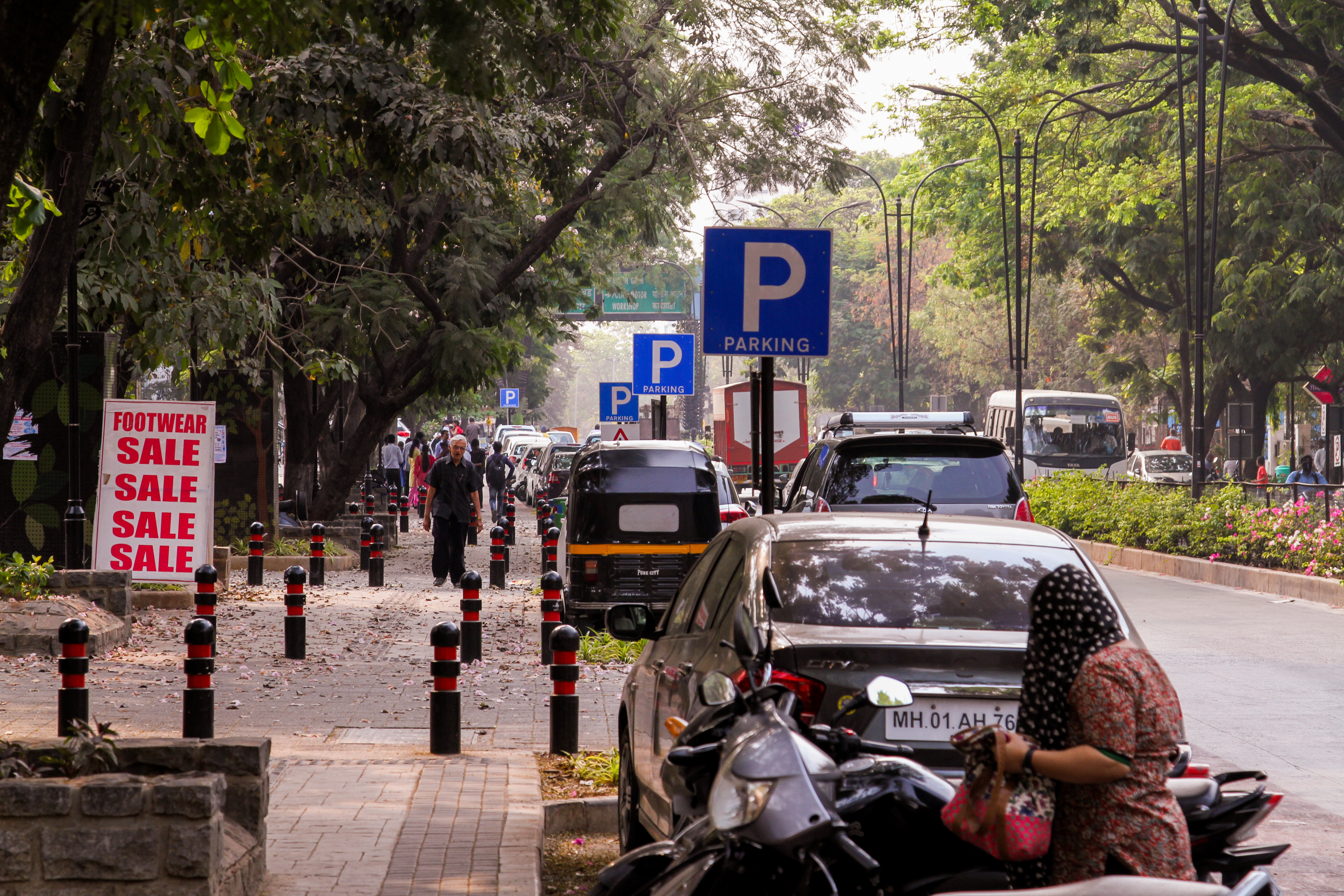
Moreover, Maharashtra also showed its willingness to improve infrastructure for walking, cycling, and public transport. The state government inched closer to adopting the Maharashtra State Urban Mobility Policy. The India Programme assisted the state government to conduct a series of six consultation workshops with public officials of various cities and other stakeholders including civil society organisations.
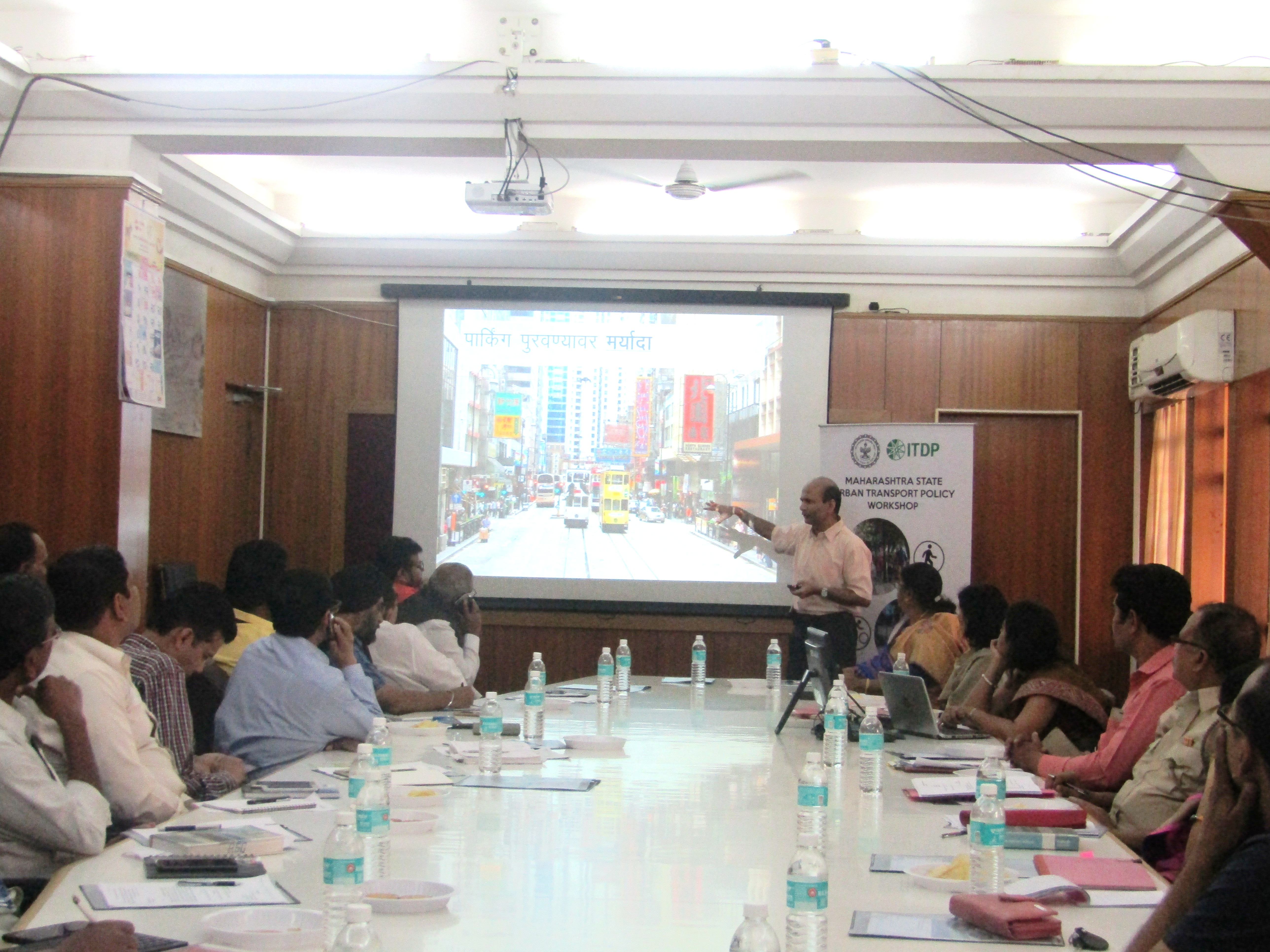
Expanding the agenda through capacity development
To ensure the sustainable mobility mantra takes shape into a belief, the concept and its principles need to be ingrained among all levels of governance. Thus, the ITDP India Programme is greatly involved in conducting capacity development workshops for officials to expand their knowledge and skills on sustainable mobility.
Over the year, the India Programme has conducted 35 workshops on Sustainable Mobility, Public Transport, and Complete Streets in Chennai, Pune, Pimpri-Chinchwad, Ranchi, and smaller cities of Tamil Nadu. Subsequently, over 1,100 government officials including senior officers of the Indian Administrative Services (IAS) and urban transport practitioners from across the country have been trained in the due course!
Engaging transport conversations in India and across the world
The India Programme’s policy brief on ‘Women and Transport in Indian Cities’ struck a chord at the Women Mobilize Women conference. Hosted in Leipzig, Germany, the first-of-its-kind conference offered a platform for women from various global transport organisations to share their personal stories on creating sustainable mobility solutions–for women and by women. The India Programme’s participation, which included moderating a panel discussion and presentation on the policy brief, was very well-received.
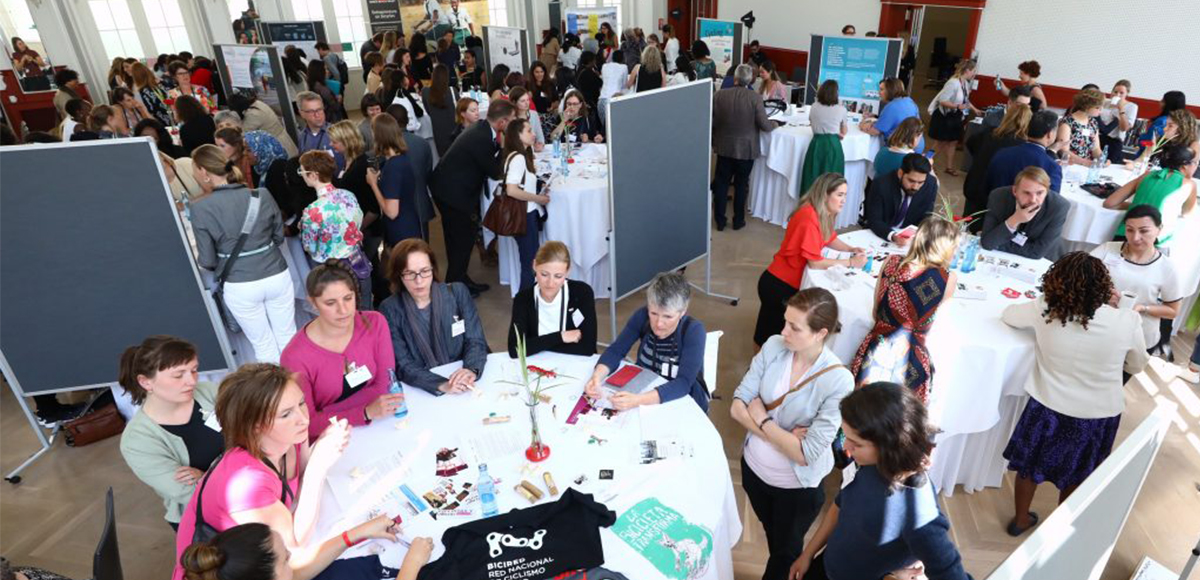
The India Programme was also invited to speak at the MOVE Global Mobility Summit 2018–which was organised by the government policy think tank NITI Aayog and attended by the Prime Minister. The dialogue laid the foundation for reinventing public transport in India, as the conference aimed at creating a public interest framework to transform transport systems.
Publishing of knowledge products
In 2018, ITDP India Programme released its publication Footpath Fix, on implementing footpaths in complex urban environments. A reference guide for urban designers, municipal engineers, and contractors, the publication was well-received by officials in the cities of Tamil Nadu and Maharashtra.
As part of the H8 Committee of the Indian Roads Congress (IRC), the India Programme provided technical inputs on the new IRC BRT Guidelines, Planning and Design of Urban Road, and IRC 70: Regulation and Control of Mixed Traffic in Urban Areas. These standards and regulations are expected to guide Indian cities towards sustainable mobility and in 2018, two of them—BRT Guidelines and IRC 70—were officially published by the IRC.
Forthcoming endeavours for 2019
Recognising the need for sustainable and accessible-for-all mobility, the Ministry of Housing and Urban Affairs (MoHUA) of the Government of India has sought the India Programme’s help for the creation of a series of five complete streets publications. Based on these documents, the India Programme will facilitate nation-wide capacity development workshops to guide the 100 cities, selected under Smart City Mission, to create smarter streets for its people!
Furthering its bid for sustainable urban transport, Maharashtra, with the technical expertise of ITDP India Programme, aspires to roll out a plan to procure 65,000 buses to improve intra-city and regional connectivity. Hence, signing off on the state’s concerted attempt to meet its travel needs in a sustainable fashion.
In a bid to broaden its horizon, the India Programme is venturing into new research areas including a comprehensive study on Congestion Pricing for the Mumbai Metropolitan Region Development Authority (MMRDA). The study will assess the need and effectiveness of congestion pricing as a Travel Demand Management (TDM) measure and evaluate challenges and opportunities in its implementation in Greater Mumbai. Given its scope, the study can also guide other Indian cities to plan and implement the same.
Work is underway, at both the state and national level, to weave sustainable mobility into India’s urban reality. And the India Programme is at the forefront of streamlining the transition. Here’s to all the hard work of the year gone by and looking forward to many such concerted efforts in the upcoming year.
As stated early on, the path to reimagine Indian cities from the perspective of equitability, livability, and sustainability is full of good work and ITDP India Programme is all set for the long haul.
Written by Rohit James
Edited by Kashmira Medhora Dubash

Tamil Nadu is urbanising and based on recent trends, the state is expected to be the most urbanised by 2030. With 11 Tamil Nadu cities being part of the Smart City Mission, it reflects the aspiration and potential that smaller townships hold to become urban centres. This is where capacity building and development exercises help bridge their aspirations with realistic and sustainable solutions.
At this point, many municipalities are growing faster than their projected trajectory, which has begun disrupting the established planning layout. To counter this spurt of growth, municipal officials on most occasions resort to quick fixes or knee-jerk solutions which in the future can further accelerate their woes.
Taking notice of this worrying development, the Commissionerate of Municipal Administration (CMA), in partnership with the Tamil Nadu Institute of Urban Studies (TNIUS) and the ITDP India Programme, commissioned the capacity building programme on urban planning. The program was structured to help prepare town planners and panchayat officials to create streets and public spaces which meet the standards of upcoming smart cities.
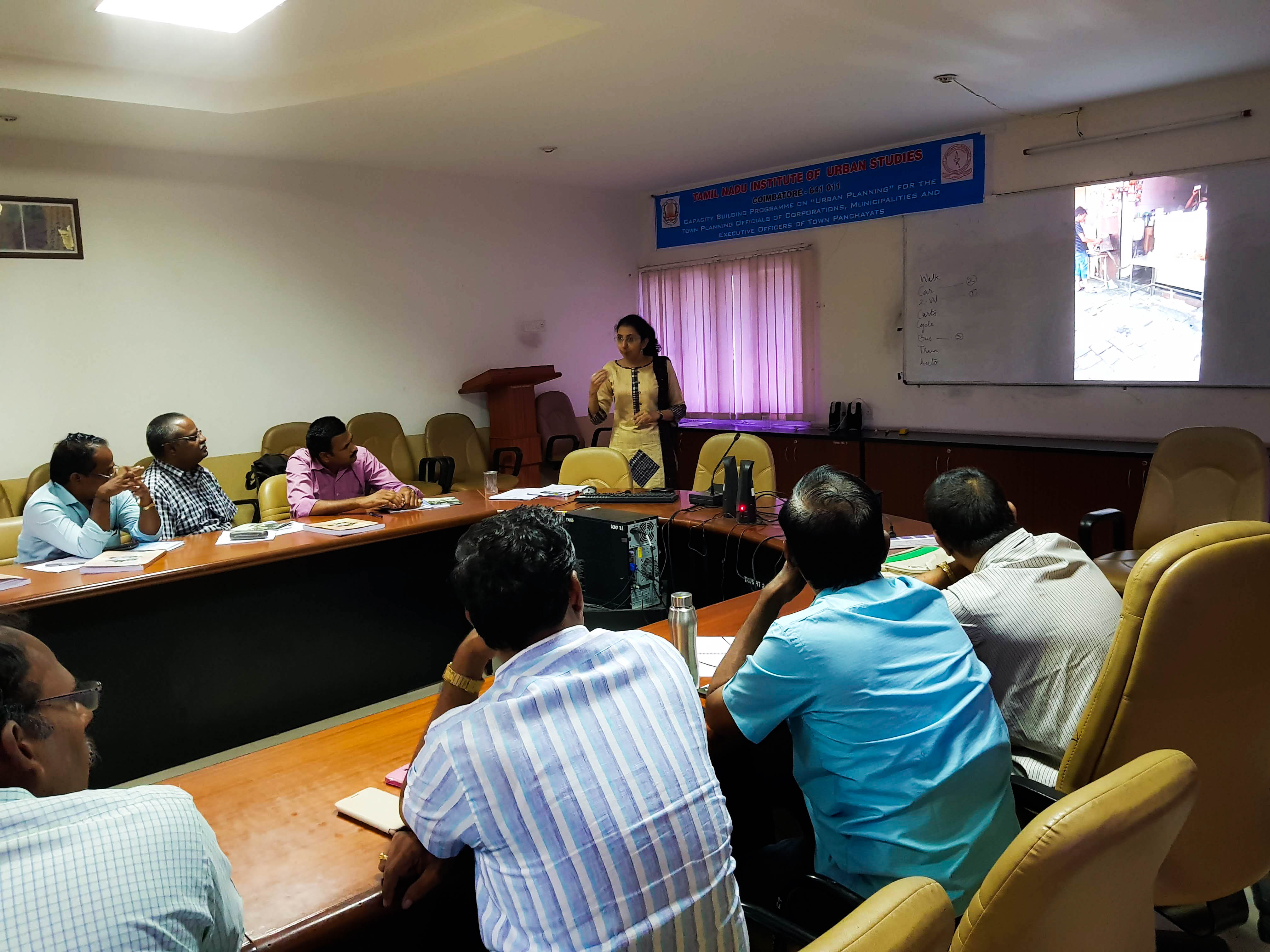
Shifting from streets for vehicles, to streets for all
In the midst of modernisation, a key component of civic planning that is often overlooked is equitable street design. To help towns and municipalities reimagine and structure streets, beyond just accommodating the rampant vehicle population, the India Programme was brought on board to share its expertise in creating complete streets which adhere to every road users need.
As part of the course, the India Programme designed and conducted capacity development sessions for over 240 town planners from about 100 municipalities that was spread across three months.

In absence of such interventions, town planners tend to sway to the tune of vehicle-centric planning; this at the expense of safe footpaths and cycling facilities. While carriageways only get broader and footpaths narrower! Hence, such developmental workshops help officials realise the need for equality and accessibility while laying out streets. Emphasis was put on creating and improving infrastructure for pedestrians and cyclists—who account as the primary occupants of Indian urban roads.
Making sense of Complete Streets
‘What are Complete Streets?’ When asked to express their understanding of the concept, the responses from officials varied from ‘streets that are planned for better vehicular passage’ to it being ‘foreign/alien’ to them.
So, what are Complete Streets?
Complete Streets are street layouts that cater to all user groups—regardless of their age, gender, ability, or mode of transportation. They are designed with wide and continuous footpaths, safe pedestrian crossings, separate cycle tracks (where applicable), bus stops designed to enhance convenience, designated on-street parking, organised street vending, and properly-scaled carriageways. These streets are designed to offer the best of convenience and comfort based on local needs and offer spaces for relaxation, play, and interaction.
Understanding the essence of Complete Streets
Since motor vehicles have been dominating every square inch of our urban infrastructure and design plans, the sessions began with a bit of a reality check. Participants, including town planning inspectors, executive officers, and town planning officers, were introduced to general facts such as modal share, infrastructure inadequacies, misconceptions regarding road infrastructure planning, etc.
This turned out to be an important step in the process, as it helped expose the misbelief that motor vehicles transport more people than any other transportation mode. Walking and cycling accounts for 40-50% of the total modal share, and just a quarter of urban trips are on personal motor vehicles.

To further quash the fallacy, officials were shown multiple images of vehicle-centric design plans which were riddled with flaws—unusable or absent footpaths, rampant on-street parking encroachments, haphazard pedestrian crossings, etc. On realising the potential threat such single-pronged plan would generate, more officials realised why streets need to designed for all users than just vehicles.
Providing the tools for change
Understanding the flaw is just one part of the solution, the next step required acceptance and gumption to resolve it. Hence, the following session looked to tackle the incessant argument claiming, ‘Our town streets aren’t like cities, they are too small to adopt such measures.’
By sensitising officials to multiple examples of Indian streets, each reclaimed and refurbished according to best practices, many of the skeptics were won over by the effectiveness of the Complete Street programme. For example, the redesign of JM Road and DP Road in Pune; which has been lauded across the country, even winning the Housing and Urban Development Corporation Award and the Volvo Mobility Award 2017.
Further on, the basic components of Complete Streets were broken down and each element was interactively explained to officials.
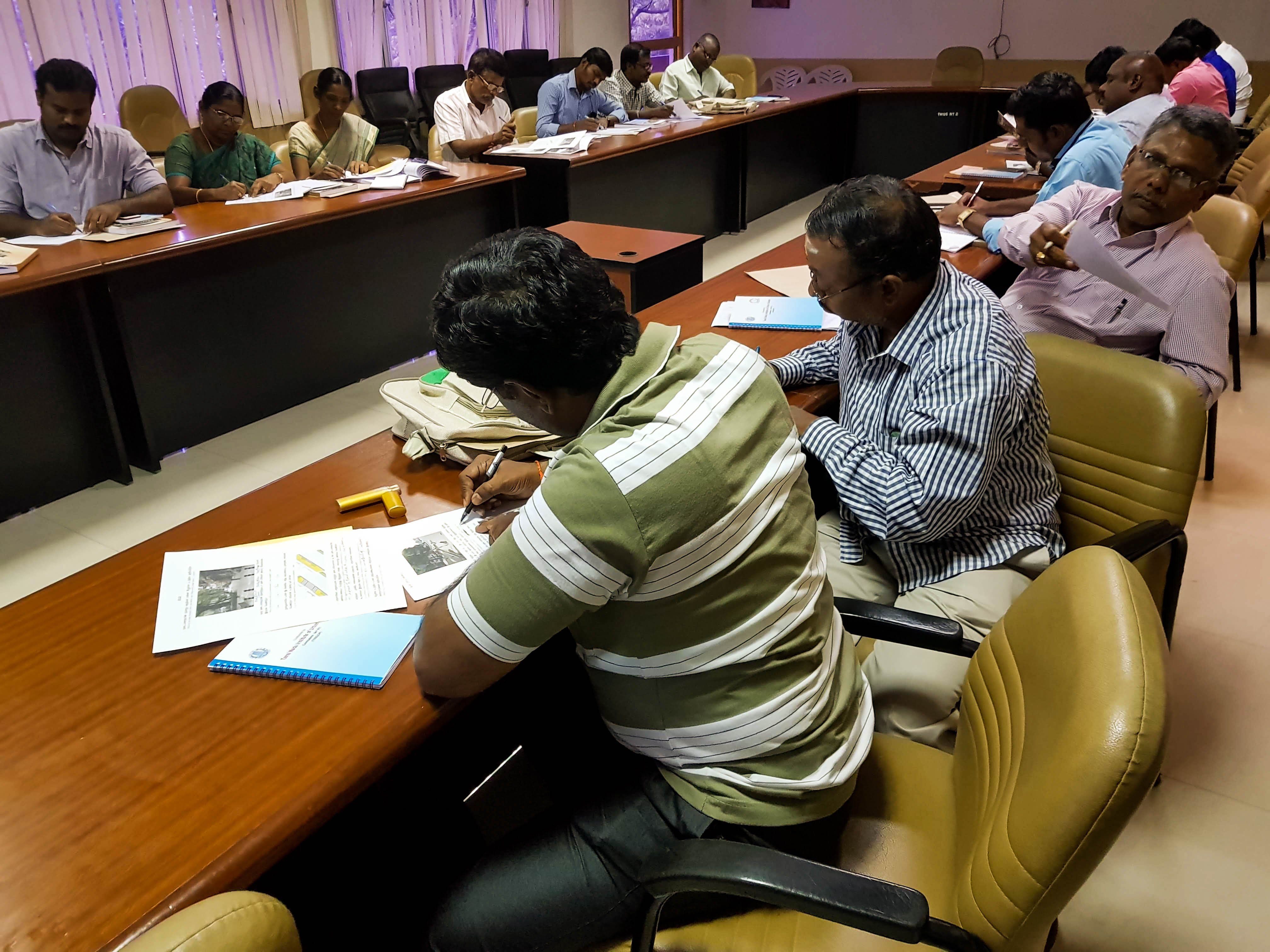
To further enable their understanding of the concept, ITDP’s resources—such as Footpath Fix and Footpath Design for designing and constructing standardised footpaths and Parking Basics and Park it Right for creating means for a parking management system—were discussed and later shared with the participants for further reference.
At the pace towns are developing in Tamil Nadu, 2030 does not seem like a distant future. Therefore, such capacity development sessions go a long way to instil concepts of sustainable and equitable mobility culture right at the grassroot levels. In essence, preparing these townships to meet their aspirations and ensure it is done for the people and not vehicles.
Written by Rohit James
Edited by Kashmira Medhora Dubash
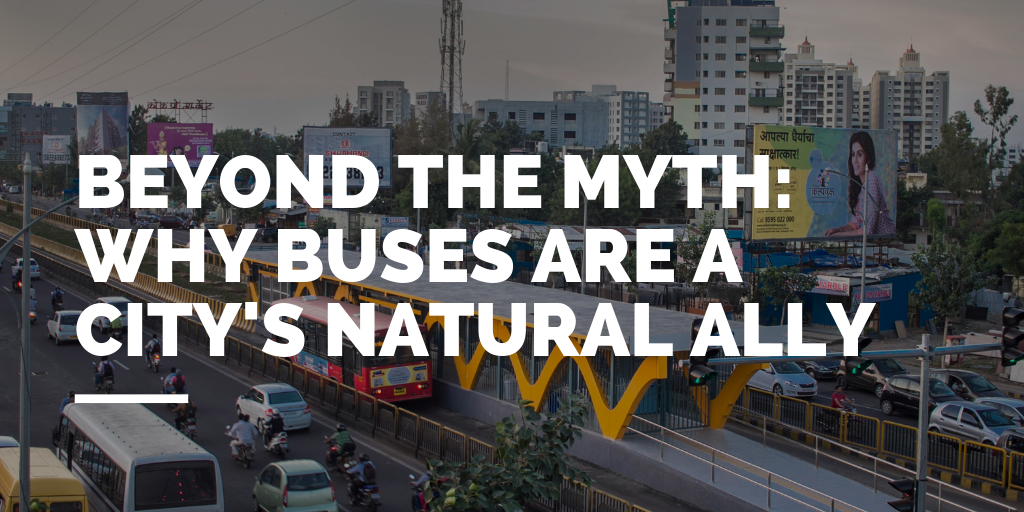
Standing at a crucial intersection, bus transportation faces the possibility of being a footnote in Indian history. Lest we forget, buses were, and in most cases continue to be, the backbone of a city’s travel needs. But at the turn of the century, globalisation established its roots in Indian cities and with it arrived new technology, improved purchasing power, and far-reaching aspirations—fuelled by marketing gimmicks.
Soon enough, the idea of the first car parked itself deep into the psyche of the masses. Interestingly, the messaging was altered according to socio-economic backgrounds. From the first motorcycle to the first scooter (eventually rebranded as the ‘scooty’). Well, why should cars have all the fun!
Etched in our memories by means of rampant baits (adverts of all sizes and forms), automobiles were perpetuated as the vehicles for our ‘escape from Alcatraz’. Just for one tiny-little gargantuan problem! The light that flickered at the end of that tunnel was decimated by tonnes of reinforced steel and million gallons of cement. That is, the more infrastructure we built to support private motor vehicles the more congestion was created on the streets; resulting in ever-increasing pollution levels.
As per a report, published by the University of Chicago, automobiles contribute a quarter of the PM 2.5 released into the atmosphere. “Particulate pollution cuts global life expectancy short by nearly two years; and in India, it is an average of four years! In comparison, smoking cuts global life expectancy by 1.6 years,” states the report.
And in all of this, commute hours only managed to worsen. Hence, countries at large are adopting sustainable and ecological public transport measures such as buses. But in India, there still exists a certain disdain when it comes to using buses in the urban scenario.
In order to rid ourselves of this baseless confirmation bias, we need to understand what these myths are and where they stand when viewed with rationale.

The comfort of a private vehicle comes with a certain privilege and in time, anything outside of that zone is viewed with a myopic lens. A huge part of this delusion is that everyone travels by either car, two-wheelers, or now, cabs. The fact, though, is different from the distortion.
Less than a fourth of all trips are on personal motor vehicles and cabs, while over a quarter is made on public transport. And, city buses cater to most of the public transport trips in major Indian cities. Like in the case of Bengaluru and Delhi, where bus services record more than five million trips per day. This begs the question, where are the buses?!
In the case of Chennai, with a population touching close to 10 million, there are just about 4,000 operational buses in the city. According to national service level benchmarks, there should be 400 – 600 buses per million inhabitants in cities. Most Indian cities fall short of this number. Going by that standard, Chennai records a shortfall of close to 2,000 buses. Even so, the city’s Metropolitan Transport Corporation (MTC) records an incredible 4.7 million daily ridership—resulting in overcrowding and poor level of service.
To cope up with the demand and maintain a decent level of service, cities need to be assisted either by state or national schemes. Though the JNNURM scheme drew sharp criticism, it helped bring about a massive influx of high-quality fleet—more than 13,000 buses were added to city bus systems across the country.
Indian cities aren’t the exception to the public transportation thumb rule. Cities across the world, both developed and developing, register higher bus ridership figures than any other public transport system. These include London, Singapore, Hong Kong, Mexico City, São Paulo, etc.

Let’s begin by addressing the elephant in the room. Buses, though big, are not the reason behind congestion on roads. The credit goes to private motor vehicles, like cars and two-wheelers, which through their sheer numbers manage to clutter every possible infrastructure created to ease their passage.
Back in 1991, Munster, in Germany, put on display a three-panelled photograph. Titled ‘Waste of Space’, it depicted the space required to transport 72 people by either car, bus or bicycle. And as the adage goes: an image is worth a thousand words. To spell it out, cars occupy a lot more space and carry a lot lesser people. Whereas, a bus can carry a lot more people and occupy a lot less space on the road.
Here are some stats to bolster this argument: a bus, while thrice the size of a car it carries thirty times more passengers during the course of a day in a typical Indian city. While cars occupy most of our street space, they serve less than a fourth of all trips. They also sit idle for 95 per cent of the time. And just like an elephant cannot survive on peanuts, infrastructure (flyovers, free parking lots, road expansion, etc.,) to support private automobiles burns meteor-sized holes in public expenditure.

Now, cynics would argue that realistically buses get stuck for longer in traffic and comfort levels vary according to passenger density or crowding. Well, obviously! If you pack roads, of how-many-ever lanes, with a swarm of private motor vehicles no one would be able to commute efficiently. But what if buses have a lane of their own?
In the present scenario, a city spends around Rs 200-300 crore per km in building a four-lane flyover to increase capacity by 60%. Whereas, investing in a bus-rapid transit (BRT) at-grade would ensure road capacity to increase anywhere from 400-1,000 per cent and cost approximately Rs 20 crore per km—just one-tenth the cost of building a flyover. When designed at par with international standards, the BRT system not only transports more commuters but ensures faster transit and accessibility to folks from all walks—especially the differently-abled and children.
Hence if cities are looking for efficient modes of transport, a rapid transit system such as the BRT is the answer.

There is no doubt that rail and some metro (Delhi and Kolkata) systems are shining examples of high-quality and high-capacity urban public transit, but buses were the original beast of this burden. Even as the baton is being handed over, bus services continue to carry a significant chunk of the ridership.
In the 2015-16 period, the Delhi Metro Rail Corporation (DMRC) recorded their highest yearly average in ridership—2.5 million commuters per day. Compare this to the city’s bus services, which recorded a massive 4.8 million ridership.
Most importantly, metro rail projects don’t come cheap. Chennai’s phase-I, which covers 45 km, pushed the city’s finances by about Rs 250 billion and the 108 km phase-II project is estimated to be a whopping Rs 850 billion—that is Rs 8 billion per kilometer!. The cost of the project is further borne by citizens, as the Chennai Metro is likely to be the costliest metro rail in the country. So the question arises, should a city spend Rs 8 billion on one kilometer of underground metro line and serve 10,000 passengers or build a 40 km high-quality bus rapid transit network which can serve upwards of a lakh passengers.
As sustainability becomes the need of the hour, bus-related transport systems are winning endorsements from cities and experts alike. According to the former Transportation Commissioner of New York City, Janette Sadik Khan, the model of roadway design—to move cars as fast as possible from point A to B—is outdated and needs to be updated. “Streets are the major capital asset for cities…They can be used to provide all sorts of mobility, like the Bus Rapid Transit system (BRTS). We can build high-capacity systems that can make it easier and more affordable and faster for people to move around,” said Khan in an interview to The Hindu.
So rather than neglecting this perennial lifeline, Indian cities need to take advantage of their already well-established bus systems. As Oscar Wilde put it, “Life is not complex. We are complex. Life is simple, and the simple thing is the right thing.” In the same context, urban mobility isn’t complex and a simple and humble transport medium such as the bus could unravel the complexities of Indian transportation.
Written by Rohit James
Edited by Kashmira Medhora Dubash
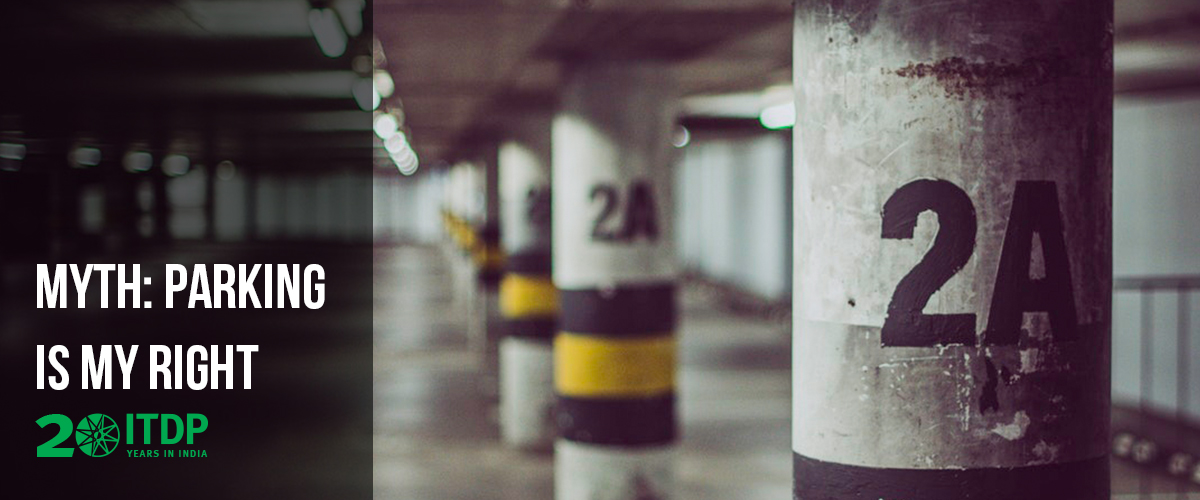
In the 1970s when Joni Mitchell crooned “Big Yellow Taxi”, not many realised the clairvoyance and the forewarning that the song’s lyrics expressed. Though every bit of the lyric has its own essence and social messaging, the starting couplet is resounding. The verse—“They paved paradise, And put up a parking lot”—held a mirror up to society, and here we are four decades later, perplexed and baffled as to how we got here.
Automobiles are the scourge that drive up emission levels and other environmental issues, yet their numbers continue to rise unabashed. As per a report by the Centre for Science and Environment (Delhi), it took India 60 years (1951-2008) to cross the mark of 105 million registered vehicles. The same number of vehicles were added in a mere six years (2009 – 2015) thereafter!
But when you throw ill-conceived parking systems into this mix, it is like taking gasoline to a firefight. The backlash of this self-inflicted problem is found in every nook and corner of our cities, in all sorts of positions (angular, parallel, perpendicular) and scales (on-street, multi-level, automated).
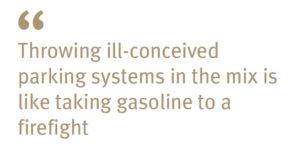
In India, the conversation surrounding parking management is kindled every now and then, only to be impounded with plans of creating more parking spaces. Or even worse, buried six-foot deep with a parking lot as a symbolical headstone. Irony at its best.
So, why is it that dialogues on parking and its management generate public ire, whereas implausible measures—such as unchecked on-street free parking and multi-level parking—venerated. The answer lies in the psyche of vehicle owners and commuters in general, who lay fodder to a whole bunch of myths regarding parking management.
Now, what are these myths and how do the arguments hold; well, not as solid as the ground their vehicles are parked on.

Let’s deduce this argument with the adage, “Your liberty to swing your fist ends just where my nose begins”. A citizen has the liberty to own a vehicle, but it doesn’t entitle them to occupy a public space of their fancy. Furthermore, no text, context, and subtext of a right allows for the infringement of someone else’s right. Whereas, parking poses as an obstruction for someone to use that common public space from walking or cycling.
Clearly, parking is not a right or an entitlement, but a privilege which needs to be charged and heavily at that. A parking fee must be charged proportional to demand, factoring in criteria such as location, time of day, duration of parking, and category of vehicle (defined by size and type).
Take the case of Ranchi, where a pilot parking management project on the arterial MG Road stretch led to a 12-fold increase in parking revenue. Even the state of Jharkhand, spurred by the revenue spike at Ranchi’s pilot parking management project, invested efforts to regulate parking as a statewide policy. According to reports, Greater Chennai Corporation stands to gain Rs 55 crore per year in revenue from the pricing of about 12,000 ECS (equivalent car spaces) of parking in Chennai: a whopping 110 times increase in revenue from what it presently earns.
Cities can innovatively use parking revenue to encourage sustainable modes of transport. For example, Bicing—the public cycle-sharing program in Barcelona—is financed by its parking revenue. London’s Freedom Pass, which allows elderly (60+) and disabled residents to use public transport for free, is funded by the parking fees collected in many boroughs. You can find more about these cases and other best practices in ITDP’s publication, Europe’s Parking U-Turn: From Accommodation to Regulation.

As per Dalia Research, the average global commute time per workday is 1 hour 9 minutes, India’s commute estimate hovers around 1 hour 31 minutes. That figure helps us to the third spot in the global list, behind only Israel and the UAE. So does the solution of offering more parking space offer a concession on congestion, the answer is and has always been in the negative.
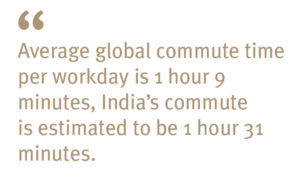
An analogy often used while talking about urban commute is “Travel time was so much lesser when there were lesser vehicle!”. Hence, parking is to private vehicles, what flame is to moths. More parking only begets more private vehicles to hit the road.
An excessive supply of parking will only encourage people to use personal motor vehicles—even when good public transport is available. Cities, therefore, need to limit total parking supply, including off-street and on-street parking. Based on the capacity of the road network, cities must set caps on the total quantum of parking available in each zone.
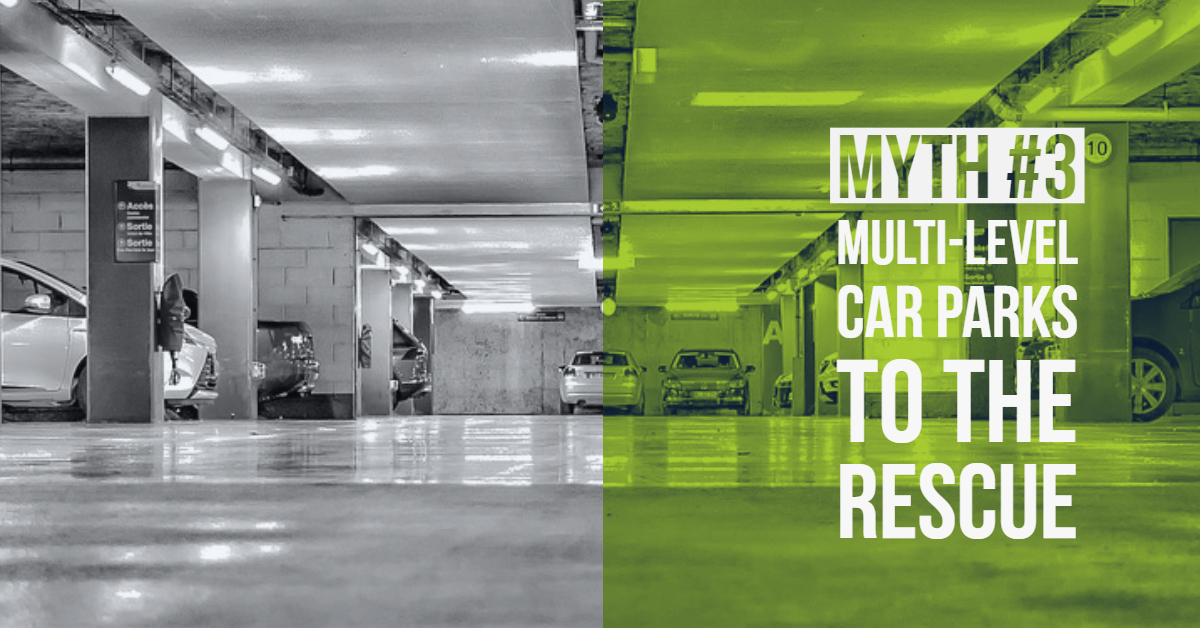
Most cities invest in developing multi-level car parks to resolve parking woes. But examples, from across the world and India, clearly indicate that it is a myopic attempt. Over time such infrastructures only turn into ‘big white elephants’.

Take the example of Bengaluru’s 11 multi-storeyed parking complexes—Bengaluru Metropolitan Transport Company (BMTC) owns nine and the Bruhat Bengaluru Mahanagara Palike (BBMP) owns two. According to a Bangalore Mirror report, these “ghost storey” parking lots barely have 20-30% occupancy, reason being parking on roads or pavements is easier, since it is free and the safer.
“Multi-level car parking doesn’t solve parking woes, better on-street management does. Multi-level parking structures remain empty while people continue to park on the streets as long as it remains free and unenforced,” said Shreya Gadepalli, ITDP India Programme Lead. Thus, cities must manage and enforce on-street parking effectively before building any off-street parking facilities, public, or private.

In 2009, Janette Sadik-Khan, the then transportation commissioner of New York City, envisioned Times Square to be a car-free zone. That is, the hub would be less of a conduit for vehicles and an urban space where people could freely walk, sightsee, dine, and take in the magnanimity that is New York. Though there were initial reservations, the results were quite remarkable and by 2010 the changes were made permanent. Citylab reported that “business for merchants in the area was booming, and travel times for cars actually went down”.
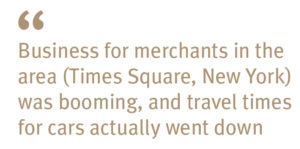
There are plenty of such examples be it Hong Kong—where demand for commercial establishments rose post pedestrianisation, Copenhagen—a pilot pedestrian project from 1962 has since reclaimed 100,000 sq.m of motorised transit. Here in India, the Mall Road in Shimla, Temple Street in Madurai, and Heritage Street in Amritsar are examples of how reinventing urban design to focus on pedestrianisation does not affect commercial establishment as feared.
People over parking: regulations allows better streets, better cities, better lives
In conclusion, the need of the hour is to regulate parking, not to take it off the table. Policies which focus on parking management not only help in easing congestion, emissions, and travel time, but also are a feasible revenue generation model for a city. A robust management system clearly defines parking zones, pegs user fee to demand, and uses an IT-based mechanism for information, payment, and enforcement—discussed at length in ITDP’s Parking Basics.
The conversation revolving around parking management has been catching up, with ITDP India Programme offering plausible solutions to cities. Leading the conversation is Pune, which is on the verge of implementing a parking management policy—a demand-based parking system that smoothens traffic movement.
Multiple studies allude that personal cars and two-wheelers occupy most of our street space, yet serve less than a fourth of all trips. They also sit idle for 95 per cent of the time—consuming over a third of street space that could be used more effectively as footpaths, cycle tracks, and bus rapid transit (BRT). The discourse over urban mobility shouldn’t revolve around parking, rather the onus must be on transit-oriented development. Wherein, last-mile connectivity and rapid system of transit ensure movement of people and not just vehicles. As cities evolve, there is an urgent need to step away from an oblivious “man proposes and parking disposes” mentality.
More resources from ITDP on parking management and reforms:
InFocus: Revolutionary Parking Reforms
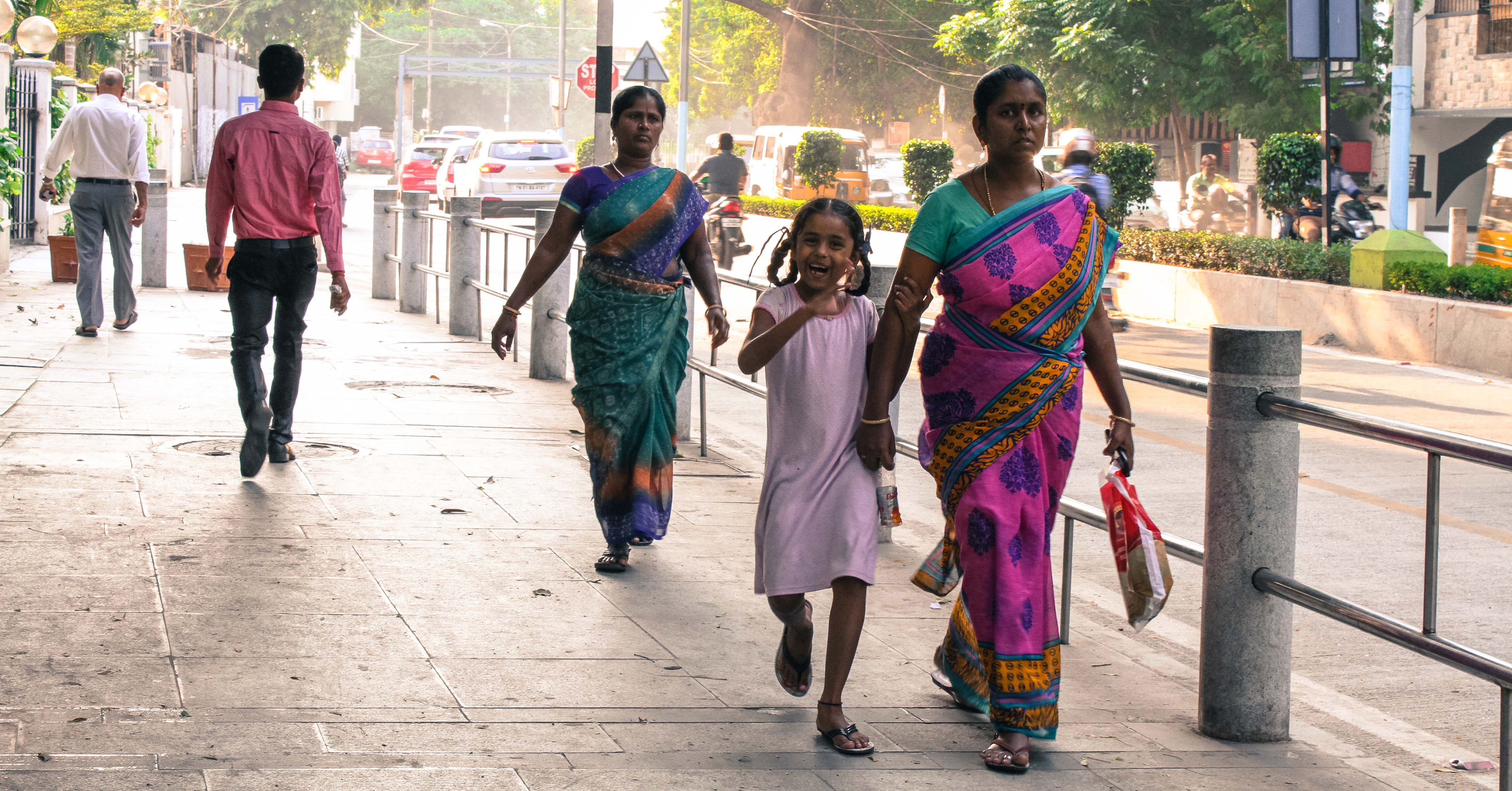
Join our webinar to hear how Indian cities can construct safe and attractive footpaths that are accessible by all. The webinar will introduce our publication – Footpath Fix – that provides guidance on footpath construction details, especially that of different utilities.
Many Indian cities have begun to acknowledge the fundamental role of walking in everyday life but are stuck at getting the details right. This short guide is more of a cheat-sheet for urban designers, municipal engineers, and contractors on how to implement footpaths in complex urban environments. Everyone who has seen it is raving about it.
Download your own FREE copy!

Date and time: Thursday 16 August, at 6pm IST
Speaker: Nashwa Naushad, Research Associate – Urban Development, ITDP India
Pranjal Kulkarni, Research Associate – Urban Development, ITDP India
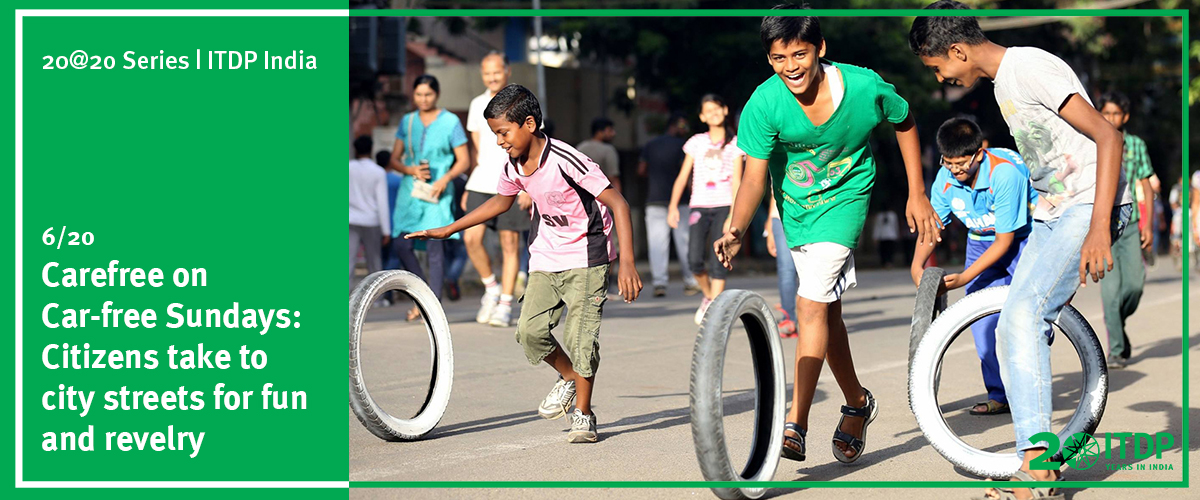
Imagine an arterial road in your city. Now, place a child running about in that stretch. Fair to assume that your brows twitched at the thought of these two events aligning. Though stark, urban dwellers are naturalised to the danger that arterial roads or streets in general hold. But to hold a static entity accountable is unfair. So where does the buck stop?
Let’s reimagine this sequence of events. Same arterial city road and same child running about carefree. This time though, cordon off vehicles from the section. Suddenly, the road seems to be devoid of chaos. It even becomes an oasis where people can come together to run, play, and enjoy themselves to their heart’s content.
Isn’t it bewildering how one component can drive our stress up the walls and still be considered an integral part of our lives. This is exactly what the “Car-free” initiative was conceptualised to debunk. Originated in the Netherlands and Belgium during the 1956 Suez Crisis, the move was planned to ration petroleum. But it took its true form in 1958, when New York City residents blocked vehicles into their neighbourhood to protest the extension of a road at the cost of a public space.
As vehicles started taking over our streets and lives, the initiative gained prominence to counter this menace. And it is with the same intention that the initiative made its way into the Indian quarters. The “Car-free Sundays” drive, proposed by ITDP India Programme in collaboration with Riverside School and other partners, was first introduced to Ahmedabad in 2009. Every Sunday, citizens were given unconditional access to three arterial stretches to experience the freedom of walking and cycling on safer car-free streets.
 India’s first car-free Sunday in Ahmedabad in 2012
India’s first car-free Sunday in Ahmedabad in 2012
It wasn’t long before other states recognised the transformative nature of the initiative. Tamil Nadu and Maharashtra were quick to come on board and transform their streets into vibrant spaces for citizens, not vehicles, to occupy.
Leading the charge in Tamil Nadu was Coimbatore. The dialogue, facilitated by ITDP, was a success. All partners –including the Coimbatore City Municipal Corporation, Residents Awareness Association of Coimbatore (RAAC), print media partners and the residents– realised that the concept would help improve walking and cycling conditions in the city.
The Corporation and the Coimbatore Police left no stones unturned to help citizens reclaim landscape lost to vehicles. With prior public consultation workshops for residents, the campaign was launched across two stretches –DB Road and T V Swamy Road– for a total of 1.7km, in 2015. This sense of emancipation was refreshing, as many came in droves to be part of the revelry. Soon accolades started pouring in, with the campaign being honoured with the Best Project Award, Non-Motorised Transport category, by India’s National Ministry of Urban Development.
 People enjoying hop-scotch at the car-free Sunday in Coimbatore
People enjoying hop-scotch at the car-free Sunday in Coimbatore
The obvious impact was soon realised by Chennai and it didn’t take much for city officials and the police to join the bandwagon, with ITDP again playing a hand holding role in collaboration with Chennai City Connect and The Hindu (media partners). Titled “Namma Chennai Namakke” (Our Chennai for Ourselves), many residents took an instant liking to the idea.
“I would love to see children aimlessly ride their cycles on the road…or adults playing badminton and pet enthusiast take their companions for a walk. I personally would indulge my pet, without the fear of him/her getting hit by a car,” said Jennifer Jacob-Murali, resident of Chennai.
 Father and daughter bonding over skipping at the car-free Sunday in Chenani
Father and daughter bonding over skipping at the car-free Sunday in Chenani
Every Sunday, the ruckus of vehicles were replaced by that of laughter and excitement. Of kids being kids and parents joining the act. Of people dancing, doing yoga, and enjoying art and craft. Of citizens, young and old, not surrendering their right to walk, run, and cycle to the chagrin of fuel guzzling automobiles.
Today, these cities have taken a step ahead towards sustainable urban transport solutions with Chennai adopting a Non-Motorised Transport Policy and Coimbatore adopting the Street Design and Management Policy. Car-free Sundays helped citizen to wake up to the possibility of enjoying public spaces like roads and streets without the hindrance and dread of vehicles. Its success gave momentum to the ‘Model Roads’ project, as citizens demanded better walking and cycling infrastructure across Coimbatore.
Not even John Lennon could have imagined how vehicles would take over lives, leaving us struggling to find our way. So an ode to his legendary vision, with a twist of our own.
Imagine there are no vehicles
It’s easy if you try
No fumes around us
Only people and the sky
Imagine all the people living for today
Cover image courtesy: Times of India, Coimbatore.

Over the past decade, cities across India have dared to dream of reimagining bus transit, most famously known as the Bus-Rapid-Transit, or the BRT. The concept of having buses ply in the centre of the road, on dedicated bus-only lanes, has gradually mulled into our urban transport systems with a tenacious aim of mobilizing people rather than cars.
India’s first high-quality bus-rapid-transit system was inaugurated in 2009 in Ahmedabad — the Janmarg bus-rapid-transit. Janmarg set a national benchmark and inspired systems across India, including the Rainbow bus-rapid-transit in the twin cities of Pune and Pimpri-Chinchwad that was launched in 2015.
The Rainbow bus-rapid-transit offers convenient commute, as efficient as a metro or a train without the cost of acquiring land, laying tracks, building large scale stations, and the pedestrian foot-over-bridge to get to them. The ITDP India Programme assisted Pune Municipal Corporation, Pimpri-Chinchwad Municipal Corporation, and Pune Mahanagar Parivahan Mahamandal Limited create physical designs and operational plans for the system.
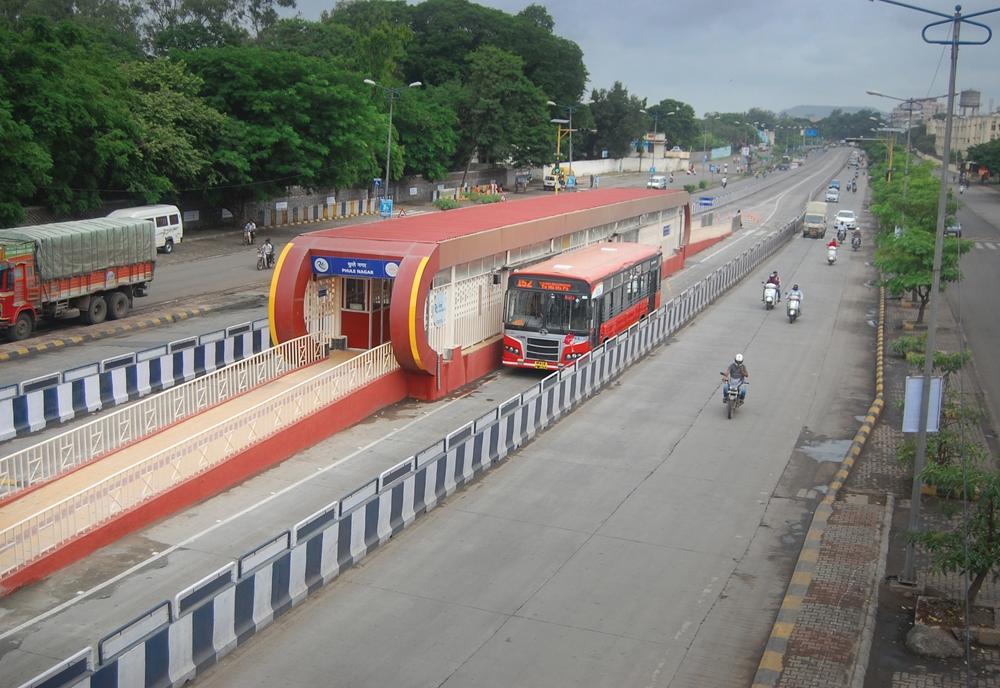
Today, the Rainbow operates along a 43 km network of bus-only lanes, with 58 stations along four corridors. However, this was Pune’s second attempt at perfecting a system that would help address the pressing issue of transport needs for the influx of population. Back in 2006, Pune piloted a 13 km bus-rapid-transit corridor but failed to meet BRT Standards.

A good bus-rapid-transit system requires dedicated bus-only-lanes, high quality bus fleet at regular frequency, a matching height of the station and bus fleet for easy step-less passenger boarding, off-board fare collection, and adequate passenger information for seamless travel. Unfortunately, the pilot bus-rapid-transit was short of meeting these basic standards.
The initial set back was not detrimental to the city regaining momentum to construct a successful bus-rapid-transit. Learning from this experience, and from the systems later commissioned in India and around the world, leaders were determined to get Rainbow right.
The Rainbow bus-rapid-transit was faced with a challenge of retrofitting a high-quality system on an existing bus network. The ITDP India programme assisted with route rationalization to deliver frequent service and ensure efficiency of the system’s fleet.
Soon after it’s launch, Rainbow was awarded the ‘Outstanding Contribution to Sustainable Mobility’ at the Volvo Sustainable Mobility Awards 2015. The award was attributed to it’s efficiency of mobilizing thousands of commuters, and travel time savings. Dedicated bus lanes ensured that commuters reach their destinations 10 to 15 minutes earlier than usual.
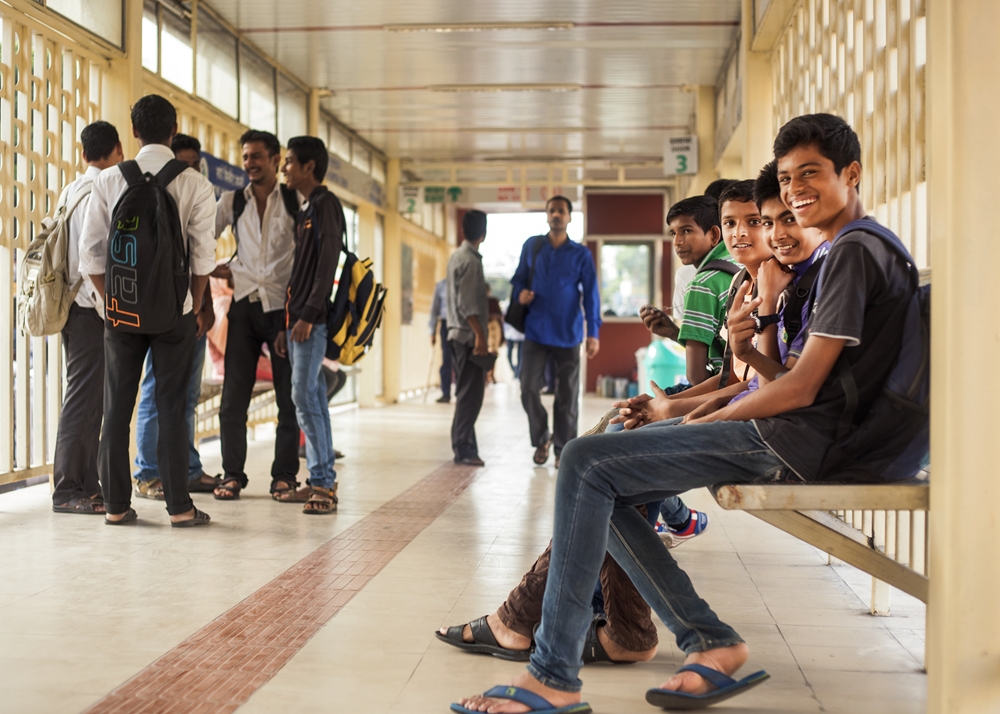
Rainbow bus-rapid-transit started off well but has failed to achieve its full potential. Ridership has only increased by 12-17 percent over the three years while the number of personal motor vehicles on the road has been growing unabated due to infrequency of buses. Considered a first for any urban area in India, Pune’s total number of vehicles has surpassed the human population!
Lack of cleanliness of stations areas attributed to the public’s demeaning perception of the system. Walking and cycling access to bus-rapid-transit stations is the dire need of the hour but yet to be developed along most corridors.
In an era where financial resources are sparse but population growth is inevitable, large-scale public transport systems are difficult to conceive. An expansion of the the Rainbow system is being planned for an additional 45 km network. This is because the twin cities strongly believe that the Rainbow can provide a solid backbone to the urban transit system.
A major limitation to the bus-rapid-transit system is also the stigma that comes with being a ‘bus’. This can be addressed through better system design, well-maintained stations, and most importantly bus-only lanes to make the users feel like it worth leaving the car back at home.
Finally, for the success of any bus-rapid-transit system it is essential to periodically assess the infrastructure and operations of each corridor, and set benchmarks to ensures its longevity. Pune and Pimpri-Chinchwad can aim for a ‘Rainbow’ future, learn from its shortfalls, and get back on the wheel to move its citizens.